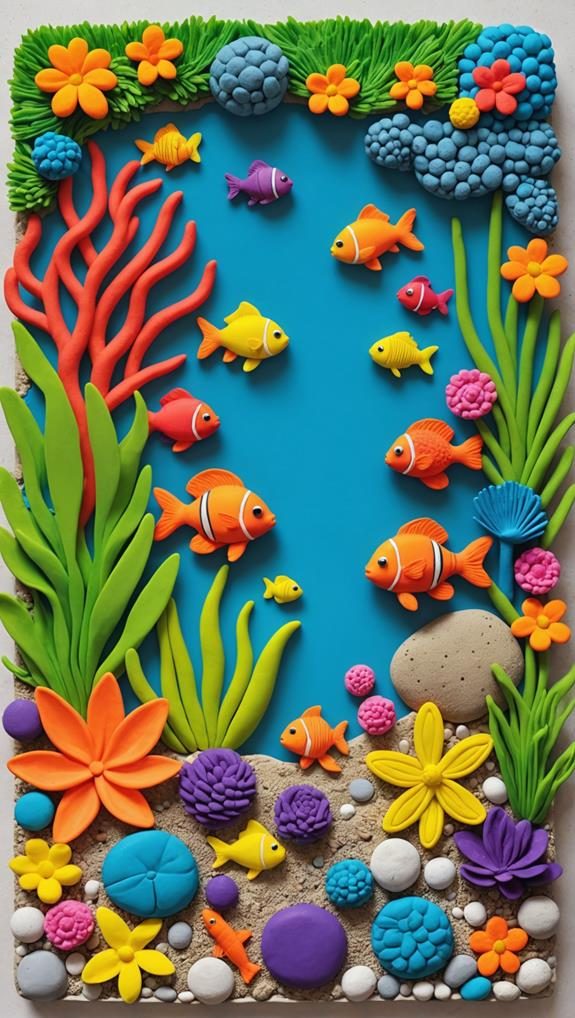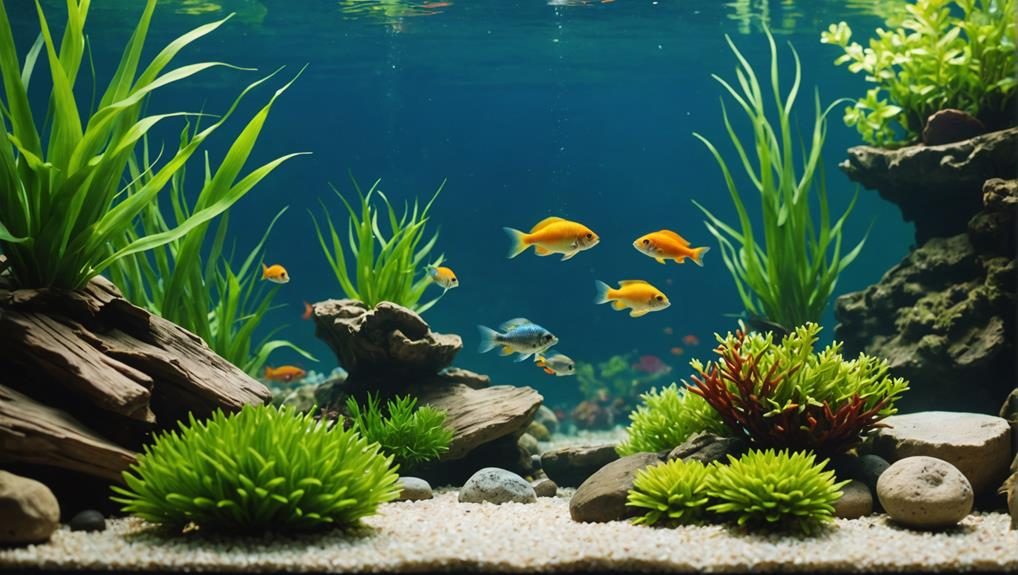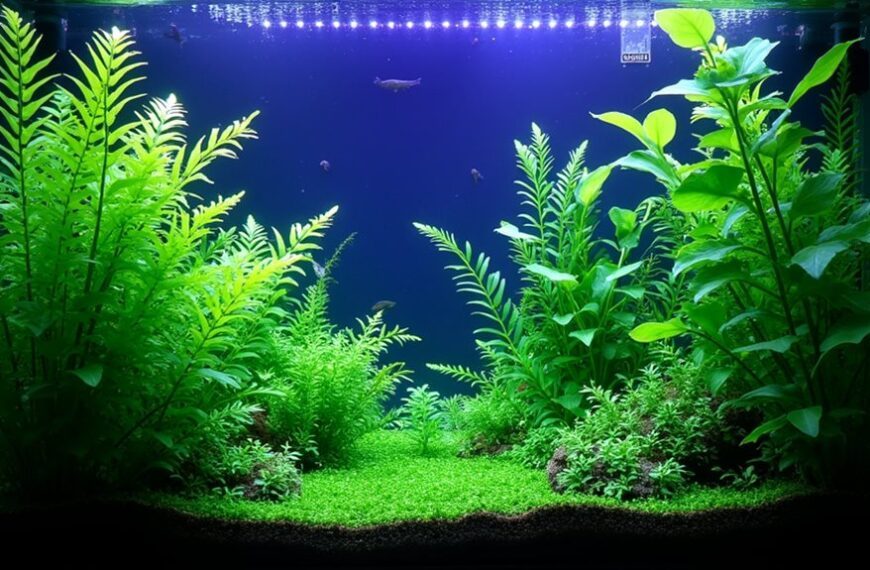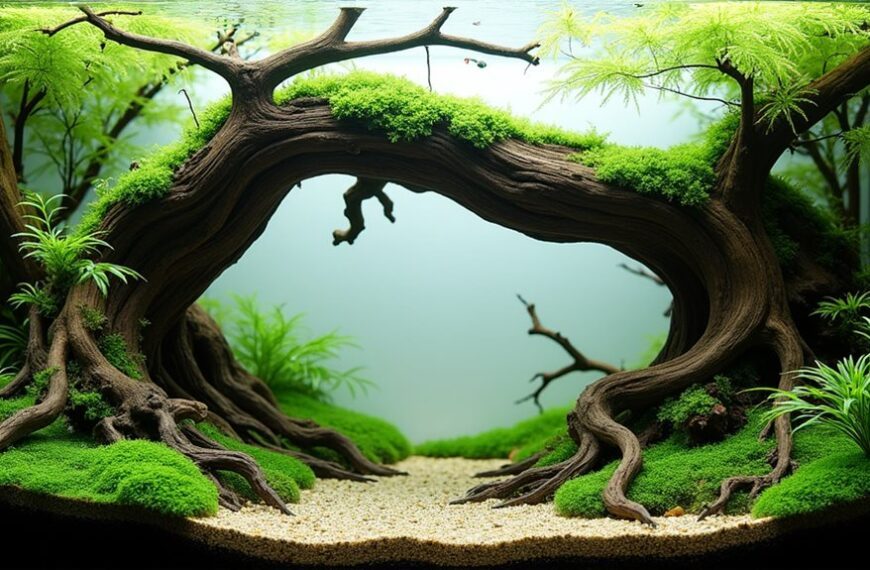When you're sprucing up your fish tank, you want to keep it safe and stylish! Start with natural stones like granite or river rocks—they look amazing and help with water chemistry. Driftwood's next; it creates cozy hiding spots for your fish. For easy decor, choose non-toxic ceramics but skip the glazed kinds to avoid heavy metals. High-quality silk plants are also a hit; they require no special care and look great. Don't forget non-toxic substrates like playsand or pea gravel! Lastly, decorative glass can elevate your tank's aesthetics while keeping fish health intact. Stick around, and you'll discover even more tips!
Contents
Natural Stones
When it comes to decorating your fish tank, natural stones can add both beauty and stability to the underwater landscape.
They're not just pretty to look at; they can also help maintain water chemistry, which is essential for your aquatic friends. Certain stones can even serve as a home to beneficial bacteria, crucial for waste breakdown and maintaining water quality important roles of substrate.
Think about using river rocks or igneous stones like granite. These options are safe and smooth, reducing the risk of injury for your fish.
Before you dive in, remember to prep those stones. Boiling them for an hour helps eliminate any contaminants that could harm your fish. Just think of it as giving them a spa day!
While glittery quartz may catch your eye, steer clear of any colored minerals containing copper or aluminum; they can be toxic to your finned buddies.
Driftwood Options
Driftwood is a fantastic addition to any fish tank, offering both aesthetic appeal and functional benefits. Not only does it create beneficial hiding spots for your fish, but it also mimics their natural habitat, helping them feel secure and at home. Additionally, using driftwood can enhance the overall water quality by promoting beneficial bacteria growth, which is essential for a balanced ecosystem optimal tank dynamics.
Before you toss that beautiful piece of driftwood into your aquarium, remember to boil it first. This step helps remove tannins, ensuring it won't mess with your water parameters.
You can also consider using hollowed-out coconuts as driftwood alternatives. They make delightful caves for cichlids, adding an extra layer of fun to your tank! If you're shopping for driftwood, look for pre-packaged options at aquarium stores. Fresh pieces come with their own set of challenges, like sap and odors that no one wants.
When arranging your driftwood, think about varying sizes and shapes. This not only enhances tank aesthetics but also adds visual depth, making your aquarium more engaging.
Safe Ceramics

Ceramics can be a stunning addition to your aquarium, but choosing the right type is crucial for your fish's safety. When it comes to safe ceramics, you'll want to stick with food-grade options. These are made in ways that limit harmful substances from leaching into the water.
However, watch out for certain glazed ceramics; they can release heavy metals like arsenic and lead. It's a good idea to research any ceramic ornaments before adding them to your tank.
Also, steer clear of painted ceramics. You really don't want to gamble with unknown chemicals that could harm your fish. High-fire ceramics are your best bet since they're less porous and less likely to leach toxins compared to low-fire kinds.
If you're considering using terracotta pots, make sure to age and soak them first. This helps prevent any unwanted changes to the pH levels in your aquarium.
Artificial Plants
Adding artificial plants to your aquarium can enhance the aesthetic without the challenges that come with live plants. You'll love how these decorations can liven up your tank while keeping things simple.
Artificial plants, especially high-quality silk plants, are safe to use and perfect for beginners, as they provide hiding spots that can reduce stress and aggression in fish, particularly Betta fish. They don't need special lighting, plant food, or trimming, making them incredibly low maintenance.
Mimics natural habitat through their design, silk plants offer a more natural appearance and last longer than plastic varieties, so you won't have to worry about them fraying over time. Plus, you can skip the worries about introducing parasites or pests into your aquarium. Just imagine that, no uninvited guests!
When selecting artificial plants, be sure to choose those with smooth edges. Rough textures can harm your fish and damage their protective slime coats.
Non-Toxic Substrates

When setting up your aquarium, selecting the right substrate is crucial for creating a safe and inviting environment for your fish.
You want to choose non-toxic substrates that won't harm your aquatic friends. Playsand is a fantastic choice with its fine texture and aesthetic appeal, while pool filter sand is both easy to maintain and promotes a healthy substrate layer.
If you're looking for something a bit different, pea gravel provides stability and a touch of variety without messing with your water chemistry.
For a visual twist, consider using volcanic rock; it's non-toxic and adds an interesting look to your tank.
Just remember, it's essential to select the right substrate size to prevent choking hazards, especially for species that might gulp down a mouthful of gravel.
While you're at it, ensure any ceramic ornaments are perfectly safe—look for ones that are unglazed and not finished.
This way, you avoid any fish toxic heavy metals that could leach into the water.
Decorative Glass
Decorative glass can elevate the visual appeal of your aquarium while ensuring a safe environment for your fish. When you choose lead-free glass with smooth edges, you're creating a stunning underwater scene that your fish will love.
Plus, these decorations don't alter water chemistry, making them safe for your aquatic friends.
Here are three tips to keep in mind when selecting decorative glass:
- Choose Smooth Edges: This prevents injuries to your fish, allowing them to swim freely without worry.
- Keep It Lead-Free: Lead can harm your fish, so always opt for lead-free glass to maintain their health.
- Regular Aquarium Maintenance: Keeping your glass clean will enhance its aesthetic appeal. Rinse it thoroughly before adding it to the tank, and don't forget to scrub it gently to prevent algae buildup.
With the right decorative glass, your aquarium can be a beautiful, safe haven for your fish.
Just remember, a little care goes a long way. Your fish will appreciate the effort, and you'll enjoy a vibrant, sparkling tank!
Safe Wood Types

When it comes to adding wood to your aquarium, you've got some great options that are both safe and stylish.
Driftwood, especially from hardwoods like oak and cypress, can create a beautiful natural look, but make sure you give it a good boil to kick out any tannins.
And while you're at it, steer clear of fresh wood—it might seem tempting, but it can bring some unwanted odors and sap into your fish's home!
Driftwood Options Explained
For aquarium enthusiasts looking to enhance their tanks with natural aesthetics, choosing the right driftwood is crucial. Driftwood options can add beauty and create hiding spots for your fish, making them feel secure.
When selecting wood, opt for hardwoods that are safe for aquariums. Here are some top choices you might consider:
- Oak – A sturdy hardwood that not only looks great but also provides excellent hiding spots for your fish.
- Cypress – This wood is naturally resistant to decay and adds a lovely touch to your tank.
- Crabapple – This safe option offers both visual interest and cozy nooks for shy fish.
Before you introduce any wood into your aquarium, make sure it's boiled to remove tannins, which can cloud your water.
Also, avoid fresh wood—it can introduce sap and unpleasant odors. Coconuts, when hollowed out and boiled, make fantastic hiding spots, especially for cichlids.
Just remember to check your driftwood regularly for sharp edges or signs of decay.
With the right driftwood, you'll create a beautiful and safe environment for your aquatic friends!
Avoid Toxic Woods
Choosing the right wood for your aquarium is essential to ensure a safe environment for your fish. You want to avoid toxic options that could harm your aquatic buddies. Stick to safe types like crabapple wood and hardwood driftwood, such as oak and cypress. These aren't only safe but also add a beautiful touch to your tank!
Before you introduce driftwood, remember to boil it. This step helps remove tannins and any harmful pathogens lurking around. Fresh wood? That's a no-go! It can release sap and odors that might make your fish uncomfortable. Instead, go for well-sourced and prepared options.
And here's a fun tip: coconut shells are great for cichlids! They provide cozy hiding spots while being completely safe.
Just be sure to avoid any treated or painted woods. Those might contain chemicals that can be toxic to your fish, and we definitely don't want that!
Frequently Asked Questions
What Materials Are Safe for Aquarium Decorations?
When choosing materials for aquarium decorations, consider natural rock choices, ceramic ornament options, wood substrate alternatives, artificial plant benefits, and resin decoration safety. These selections ensure a safe and enriching environment for your aquatic friends.
Are Plastic Fish Tank Decorations Safe?
Aren't you curious about plastic fish tank decorations' safety? If you choose durable types labeled aquarium-safe, you'll enhance aesthetics without compromising fish health. Just monitor their lifespan to avoid potential plastic decoration toxicity.
What Is Safe to Clean Aquarium Decorations?
When cleaning aquarium decorations, use non-toxic cleaning solutions like vinegar for effective decoration maintenance. Prioritize tank hygiene by scrubbing surfaces to prevent algae buildup and ensure your fish thrive in a healthy environment.
What Is the Best Material for Aquarium Cover?
You might think glass covers are the ultimate choice, but acrylic's advantages—like lighter weight and customization—make it ideal. Mesh options can enhance lid maintenance while adding a decorative function to your aquarium setup.
Final Thoughts
So there you have it—plenty of safe materials to jazz up your fish tank without turning it into a hazardous wasteland. Who knew you could create an underwater paradise with rocks and wood instead of the latest plastic fad? Remember, your aquatic buddies deserve a safe and stylish home just as much as you do! So, dive in and decorate wisely. After all, nobody wants to host a fishy version of "Survivor," right? Happy decorating!












